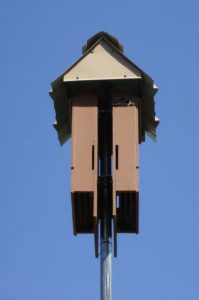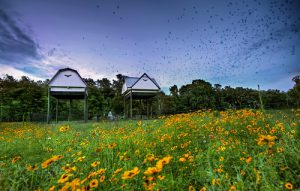Last week we began to provide backyard habitat instead of looking for them. We started with bluebird houses, and many of you have been successful at this – cool! This week we are looking at another neighborhood creature to attract that some are uncomfortable with… bats.
Many people enjoy wildlife in their yard. When I say this, I mean they like birds and butterflies – not as keen on raccoons and fox. For many, bats fall into that “not as keen” group. They are misunderstood and there is a lot of myths about them. Maybe it is because they only move at night – and there is something “dark” about them because of this. Maybe it is because they are very silent. I have watched bats fly around my house and leave in huge numbers from the bat house in Gainesville as well as Carlsbad Caverns – they do not make a sound… you just see them. I don’t know, noisy things do not seem to bother people as much as things that move with no sound at all – snakes for example. Whatever the reason, many people are not fans of bats and some are afraid of them.

Photo: University of Florida
First, bats are not “flying rats”. They do fly and are the only true flying mammals on the planet, but they are not rodents. The class Mammalia are divided into orders based on their teeth. Bat’s teeth are nothing like rodents, so they are in a different order – actually, they are in an order all by themselves – Chiroptera. Based on diversity, Chiroptera is the second largest order of mammals on the planet. There are a lot of different kinds of bats and they are found all over the world. Some are quite large, like the “flying fox” of Indonesia, some of which have a wingspan of almost five feet. And then there are tiny ones like the Kitt’s Hog-Nosed Bat (also called the Bumblebee Bat) which only reaches a length of one inch and weighs no more than a penny. Some bats eat fruit, a few small fish, some a good pollinators, and some do feed on blood (three types of vampire bats do exist), but many eat insects – and they are very good at it.
In Florida, we have 13 species of native bats – all are insect eaters. There are reports of a few Caribbean fruit eating bats that reached the Keys – but most are small bug eaters. This is an eco-service we should much appreciate. Many of them will consume thousands of insects each night. Many of these insects are considered pest in the horticulture and agriculture industries – things like the boll weevil which is a “plague” on cotton. They emerge near sunset and seek their prey using a type of sonar similar to what dolphins use. This is not because they are blind, they see fine, it is just that eyes work in light – you can’t see in the dark – so they must find their food a different way. They admit high frequency sounds that “echo” off the prey and return to their large ears and peculiar looking noses. Once detected, the bats swoop in and either grab the prey using their wings, tail, or just grab it with their mouths. They are very beneficial.

Photo: Rick O’Connor
As far as providing habitat for them in your yard, you do not need a cave. Not all bats are cave dwellers. As a matter of fact, only four of the 13 species in Florida do. The others do seek warm, dark, dry, and narrow spaces to spend their daylight hours. They can find these in hollow trees and old buildings (or neat places in new buildings 😊). These days, old trees do not stick around long. We cut them down pretty quickly. This has reduced bat populations around the state, and the insect control services they provide. How do you get them back? You build a bat house.
Here is the tricky thing… it is not easy to get bats to come to a bat house. They are pretty picky. As mentioned, they prefer warm, dry, dark, and narrow spaces. They are also leery of potential predators (like hawks and owls) and so this needs to be incorporated into the bat house plan.

Photo: University of Florida.
Most successful bat houses are about 14 inches wide and about 2 feet tall (see plans on how to build one in today’s activity section). Wood is the material of choice, but not treated wood. They like narrow chambers and you need to provide rough surface on the wood for them to grab onto – they do hang upside down like in the cartoons. It is also useful to have an extension of wood below the entrance as a landing platform. This should be at least three inches long and rough cut as well. To “roughen” the surface, small grooves can be cut into the wood about a quarter to half inch deep. Plastic mesh, hardware cloth, and metal to “roughen” have not worked well.
Painting the box is something to consider. They are very particular about the internal temperature, somewhere between 80-100°F. Depending on where you live, and where you are going to put the box – you may need to paint it a color that will either keep it cool, or warm it up. Flat exterior water-based paint is best. In north Florida, Dr. Holly Ober (UF) recommends a brown or gray color.

Photo: UF IFAS
The box needs to be watertight, but not airtight. Most designs will provide “vents” so that air will flow through, but caulking seems to keep water out is a must. Use latex caulking for this.
Once the box is finished, placement is important. Placing on trees has not worked well (I have tried). Too easy for competitors and predators to reach. They actually recommend placing the box no closer than 20 feet from a perching location for an owl or hawk. They recommend the box be at least 12 feet off the ground. Attaching to poles has been the most popular, and successful way.

Photo: Flickr
When they leave their roost, they usually first visit a freshwater source for a drink. Studies have shown that successful houses are usually within a quarter of a mile from a water source. They do not like lights. You would think lights attract insects and insects are what they eat – but as far as living, lights also attract owls who are attracted to the bats. Noise seems to be a consideration, though the street in Gainesville where the large bat houses are is pretty noisy. And keep the wasp out.
I know that people are nervous having bats around. They have been linked to rabies, but many mammals have, and they have also been linked to the CORVID-19 issue. But honestly, more disease is spread by biting insects and bats are very effective at controlling this – so they can be a benefit to public health. I hope you will learn to appreciate them as much as I do. I LOVE seeing them flying around our house at sunset.
ACTIVITY
– Sit on your front, or back, porch tonight and watch for bats. I usually will see 2-5 individuals flying around – darting after insects that are running from them – including mosquitos! But I have seen as many as 20! How many do you see?
– Consider building a bat house. I have attached to documents that both discuss bats in Florida, and how to build a bat house. They say it may take a long time for bats to move in. We have not had any yet. But we are trying.
AS ALWAYS
HAVE FUN AND STAY SAFE
Two documents on Florida bats and bat houses.
https://edis.ifas.ufl.edu/uw203
https://edis.ifas.ufl.edu/uw290
 0
0
